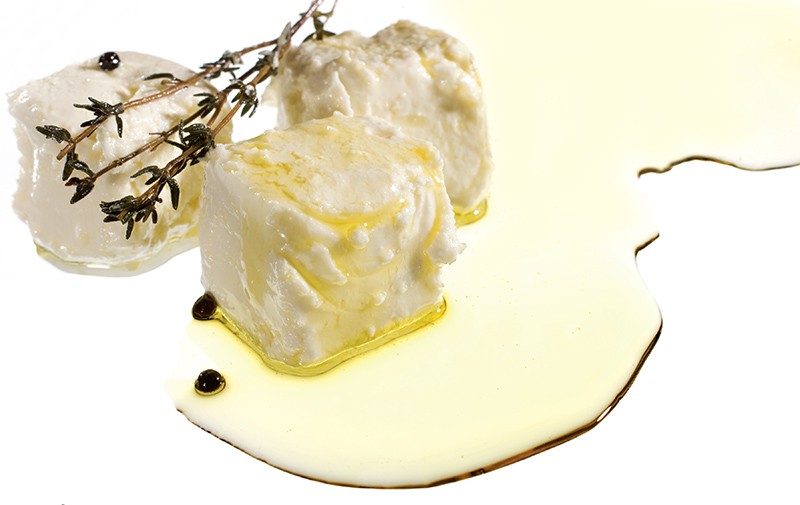
The first time I realized what a consecration it is to anoint a particular cheese with olive oil was in 1985 at a place outside Isle-sur-la-Sorgue, in the heart of Provence where Mont Ventoux looms to the north. My son Max had been born just a couple of months before. My wife, Michelle, and I chose to flee the swelter of the New York City summer, and this little baby fit perfectly into the bassinet the airline gave us to hook over the seat in front of us. (Go figure the civilized nature of that.)
We were sitting in the kitchen of this big old French farmhouse, having already shopped the farmers’ market in town that morning. It was hot. We had a fresh garrigue (the brambly, wild-herby outback of the region) chèvre on a plate, white as snow, made from the milk of the rare Roves goat breed, and some local tomatoes that somehow had ripened even in early June; they were particularly succulent. We were ripping hunks off a baguette, slicing the tomatoes, and dipping both separately into a dish filled with a Provençal olive oil that we had also drizzled atop the chèvre. The moment elicited one of those marvelous epiphanies that occur so seldom—for me, anyway. The impression was indelibly made upon me that the olive oil assumed the role of, say, the creamy, ivory-colored layer of fat around an otherwise lean slice of prosciutto; that is, the oil serves as the fat that melds and carries the flavors of the chèvre and the tomato and the bread and, finally, the olive itself, translating this meal into something much greater than the sum of its parts. Without the olive oil the repast would have been good—but merely good, rather than transcendent.
I have re-created this oil and cheese sacrament innumerable times over the years, all around the Mediterranean basin, most memorably with Pecorino Toscano—one that had been aged over a year. It happened at the Villa Scacciapensieri outside Siena, a wildly gorgeous venue, as snug and cossetting as it gets: by the ancient swimming pool nestled among olive trees and enormous rosemary and hazelnut shrubs, in the dead of a summer hotter than Hades. Picture an unfiltered Tuscan olive oil dribbled over an axe-head-size wedge of sheep’s cheese, with thick slices of unsalted Tuscan bread and a melon of some provenance that was sweeter than a Christmas carol. Again, the oil—so peppery as to be a ready-made sauce—acted as the unifier among the various textures, flavors, and big fragrances.
Obviously, the Mediterranean and its foodstuff have never gotten old for me. As I recently pondered the nature and significance of the many olive oils and cheeses I import for our Fairway stores, I was lightning-bolt-struck by the realization that all of them without exception fit into a pattern that defines a great swath of gastronomy in one fell swoop. The pattern is this: The greatest of all olive oils and my favorite cheeses live together. They are born of the same region, often of the same subregion even. And to put a finer point on this revelation, the cheeses are all made from either goat’s milk or sheep’s milk or are a combination of the two. Why does this matter? Because the pastures for goats and sheep are almost always found adjacent to, or overlapping, groves of olive trees. Everywhere in the Mediterranean basin, sheep and goats are allowed to graze freely within olive tree groves. Goats and sheep and olive trees go together. Find me a cow in an olive grove. You will not.
Which is not to suggest that cow’s milk cheeses or buffalo’s milk cheeses are not among my favorites with olive oil. They certainly are. But I am drawn to indigenous relationships—in this case ever-coy olive oils paired with the voluptuous goat’s or sheep’s cheese next door. They are as bound together as any two organic substances can be in nature yet are as dissimilar in species as one could possibly imagine. Trees and sheep? Olives and milk? Who knew. But ultimately, ours is not to question this earthly communion. Just enjoy it.
Jenkins’s Judicious Picks
Here’s a sampling of regional olive oils and cheeses destined to be great together.
Oro San Carlos and Queso de La Serena, a thistle-renneted raw milk sheep cheese
Gata-Hurdes olive oil and Queso del Tietar, a farmstead raw milk goat cheese
Sicilian Manfredi’s Barbera oil and fresh sheep’s milk ricotta
Antonio Cano Baena oil and the sharp and rustic Queso de Zuheros goat’s milk cheese
Olis de Catalunya and the great Queso Garrotxa, a firm yet moist mold-ripened, pasteurized goat’s milk cheese
Corte Olias from south-central Sardinia and Gavoi, one of the oldest of Pecorino Sardo cheeses
Peloponnese Kalamata Koroneiki and Manouri, a buttery ricotta salata-style cheese
Aniguala, oil from the Pyrenean foothills of Aragon and Queso Roncal, a hard, pressed, raw sheep’s milk cheese






